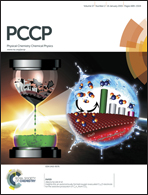Complex behaviour of vacancy point-defects in SrRuO3 thin films
Abstract
The behaviour of point defects in thin, epitaxial films of the oxide electrode SrRuO3 was probed by means of diffusion measurements. Thin-film SrRuO3 was deposited by means of pulsed laser deposition (PLD) on (100) oriented, undoped single crystal SrTiO3 substrates. 16O/18O exchange anneals were employed to probe the behavior of oxygen vacancies. Anneals were performed in the temperature range 850 ≤ T/K ≤ 1100 at an oxygen partial pressure of pO2 = 500 mbar. Samples were subsequently analyzed by means of Time-of-Flight Secondary Ion Mass Spectrometry (ToF-SIMS). The measured oxygen isotope penetration profiles comprised, surprisingly, two features. Oxygen tracer diffusion coefficients  determined for thin-film SrRuO3 are amongst the lowest measured for nominally undoped perovskite-type oxides. The activation enthalpy of oxygen tracer diffusion was found to be
determined for thin-film SrRuO3 are amongst the lowest measured for nominally undoped perovskite-type oxides. The activation enthalpy of oxygen tracer diffusion was found to be  ≈ 2 eV. Diffusion of Ti from the SrTiO3 substrates into the SrRuO3 thin films, probing the cation defects, was also observed in ToF-SIMS profiles; here, too, the diffusion profiles showed two features. The activation enthalpy of titanium diffusion was found to be ΔHDTi ≈ 4 eV. We propose a model–cation sublattice equilibration–that accounts for the appearance of two features in both anion and cation diffusion profiles. We suggest that the observed complex behavior arises from the metastable defect structure of PLD thin films and the unusual defect structure of SrRuO3.
≈ 2 eV. Diffusion of Ti from the SrTiO3 substrates into the SrRuO3 thin films, probing the cation defects, was also observed in ToF-SIMS profiles; here, too, the diffusion profiles showed two features. The activation enthalpy of titanium diffusion was found to be ΔHDTi ≈ 4 eV. We propose a model–cation sublattice equilibration–that accounts for the appearance of two features in both anion and cation diffusion profiles. We suggest that the observed complex behavior arises from the metastable defect structure of PLD thin films and the unusual defect structure of SrRuO3.



 Please wait while we load your content...
Please wait while we load your content...